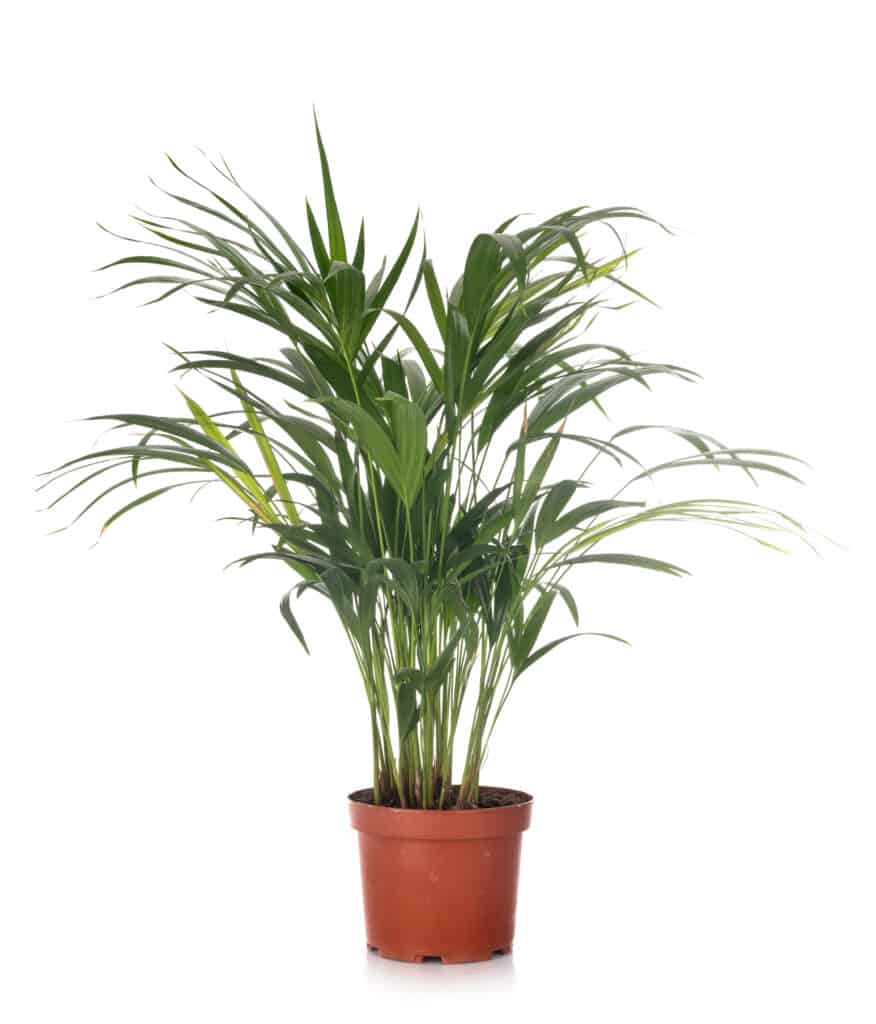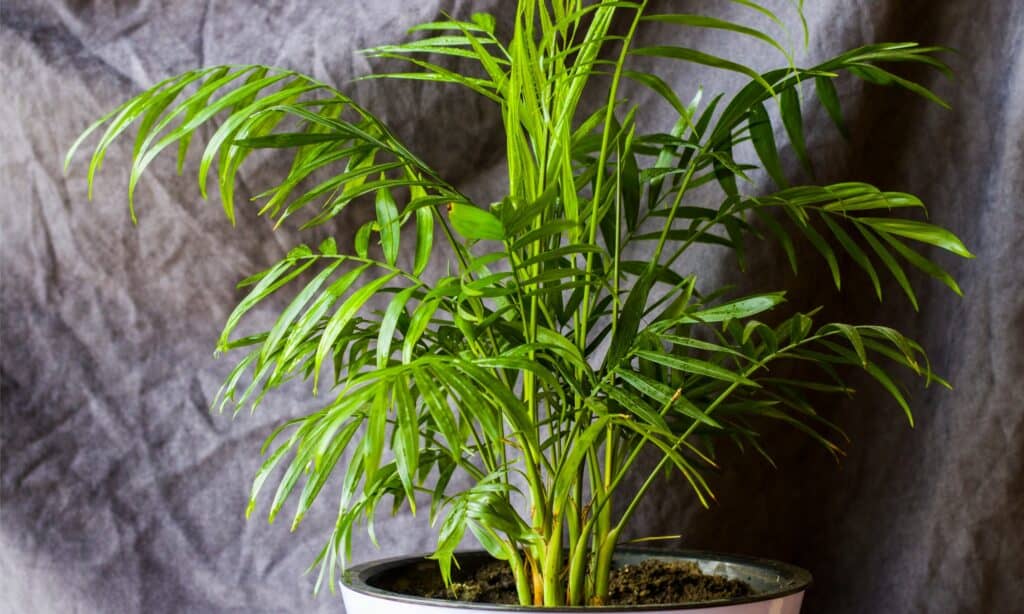Kentia and areca palms are the two most popular types of palms. Indoor palms, some of which are climbers and others more of the shrub variety, can have a significant impact on practically any room. Palms add an exotic, beautiful flare to virtually any space they are kept in.
When considering indoor palms to use as decoration, these two palms are an excellent choice. Both have advantages and disadvantages for interior spaces. They are frequently mistaken for one another as well. However, if you wish to include a palm plant in your indoor plant collection, there are some noticeable variations between the kentia palm and areca palm to take into account.
Kentia Palm vs. Areca Palm
| Kentia Palm | Areca Palm | |
|---|---|---|
| Classification | Howea forsteriana | Dypsis lutescens |
| Alternative Names | Paradise Palm | Butterfly Palm, Bamboo Palm |
| Origin | Australia | Madagascar |
| Description | An Australian palm tree that is slow-growing and has large fronds. Can grow up to 40 feet tall. | An African palm that grows in very moist climates and grows cane-shaped yellow stems. Can grow up to 30-45 feet tall. |
| Uses | Often used as houseplants or in landscaping for their aesthetics. | Often used as houseplants due to their air-purifying properties. |
| Growth Tips | Does best in acidic and sandy soil that drains well. Plant in indirect sunlight and water frequently. | Avoid overwatering and ensure that the soil drains well. Plant in full or partial sun. |
| Interesting Features | Grows outside of Australia in tropical regions such as Hawaii. Outside of tropical areas, this plant is very expensive to buy. | This plant is endangered in Madagascar. Fruits are orange at first, then slowly turn a very dark, almost black color. |
Key Differences Between Kentia Palm vs. Areca Palm

The leaves of kentia palms are wider, thicker, and bow downward; they are dark green above and paler below.
©cynoclub/Shutterstock.com
The kentia palm and the areca palm differ from each other in a number of ways. First of all, the areca palm is much larger width-wise and somewhat simpler to grow in cold areas. The kentia palm matures at a similar rate as the areca palm but doesn’t sprout any new leaves or become quite as large width-wise as the kentia palm. In addition to growing taller, the areca palm also sprouts new palm shoots from its base.
Compared to the kentia palm, the areca palm is a little more tolerant of shade. Both can handle some shade, although the kentia palm prefers more sunlight in general. The areca palm is more tolerant of shade and is frequently an understory palm in shady locations. You will be able to detect if a plant is excessively shadowed by a rapid increase in insect pests since the plant won’t be able to produce enough sugar to power all of its metabolic processes.
If you have two palm species that resemble one another and are trying to determine which is an areca palm and which is a kentia palm, the kentia is probably the smaller one or potentially the more expensive one. These have a smaller seed supply and, unlike areca palms, do not sprout branches from the base. Finer, wispier leaves of areca palms point upward like butterfly wings. The leaves of kentia palms are wider, thicker, and bow downward; they are dark green above and paler below.
Young kentia palms are frequently confused with areca palms. However, the stems that show above the ground are where the differences can be detected for young plants. Areca palms have red dots, but kentia palms have green stems with brown fibers. Additionally, the leaves of the kentia palm are wider than those of the areca palm.
Kentia Palm vs. Areca Palm: Classification

There are 51 different varieties of areca palms; many grow wonderfully indoors.
©iStock.com/Tamar Dundua
The kentia palm or Howea forsteriana is a species of flowering plant belonging to the Arecaceae palm family. It is native to Australia’s Lord Howe Island. On Lord Howe Island, it is grown by gathering wild seeds, germination, and exportation for use as a decorative garden or indoor plant.
The areca palm is indigenous to Madagascar. With about 51 different species or varieties of areca palms, the genus Areca is extremely broad and large. The one we refer to as an areca palm most frequently among these is Dypsis lutescens. Other names for this species include areca palm and bamboo palm. If you let them, these lovely palms can go as tall as 40 feet and form pretty dense clumps as they age. They are renowned for growing slowly.
Kentia Palm vs. Areca Palm: Description
The kentia palm is a beloved palm tree in the indoor plant world. The height of the kentia palm can reach over 30 feet. When fully grown, the fronds of this palm can reach a maximum height of 20 feet. This palm has a growth pattern resembling that of a coconut palm and grows upward with no new shoots. Kentia palms have coarse, thick leaves that point down with dark green coloring.
The areca palm is also a well-loved palm for growing indoors. Areca palms are generally taller than kentia palms, especially when growing outdoors, where they can reach over 40 feet. This palm grows upward like the kentia palm, but it produces new shoots at the base of the plant. Areca palms have fine, thin leaves that point up and have a medium-green hue.
Kentia Palm vs. Areca Palm: Uses
The kentia palm is a fantastic plant for amateur gardeners. It will flourish when given loving attention, and it will also withstand more careless gardeners with ease. This tropical and subtropical plant may thrive in the partial shadow of sandy or coastal environments. Kentias look lovely in pots inside, but they have a tendency to grow better outside.
The areca palm is another plant utilized for indoor landscaping. Not only do they thrive indoors, but with proper care, they can become fairly large inside a pot. Areca palms are often used as part of indoor plant families because they add a lovely splash of green color.
In general, areca palms tend to do a little bit better indoors. If you plan on planting a palm outside for landscaping purposes, provided you have the ideal environment for a palm to grow, we recommend going with a kentia palm.
Kentia Palm vs. Areca Palm: Origin and How to Grow
The kentia palm tree has gained a reputation as a result of its use as a status symbol by Queen Victoria at the height of the British Empire. As a result, it also goes by a variety of other names, including a Court palm. However, this palm is native to Australia.
The areca palm is native to the island of Madagascar. Due to the unfortunate loss of its native habitat in the wide spaces of wetland forests and along riverbanks, the areca palm is at risk of extinction in Madagascar.
The kentia palm tree is well-liked because it can withstand temperatures as low as 23 degrees F for a short period of time and can endure temperatures in the 50-59 degrees F range for extended periods of time. This indicates that in cooler regions of the world, this palm tree is a popular choice for indoor spaces.
Areca palms thrive in tropical, humid, and warm areas with year-round temperatures ranging from 77 to 86 degrees F. Areca palms are an excellent low-maintenance plant because they appear to need little care other than pruning off the larger stems every few years.
You must start growing kentia palms from seeds if you can’t find an established plant to purchase. The seeds are scarce, and trading them is strictly regulated. Nurseries frequently sow a few seeds in a single container, producing a cluster of palm trees. However, one seed is the singular source of each palm. These plants are fairly hardy, and once established, they are difficult to eradicate. These are good for semi-negligent cultivation if you’re otherwise used to just buying pre-established plants.
Bright indirect light is ideal for areca palms. The secret to growing an areca palm properly is to water it often but not too much. The soil must be moist but not soaking wet or without proper drainage. Areca palms enjoy dampness as well, so take the time to mist the leaves occasionally. Areca palms can tolerate some shade but thrive in indirect, bright light. Keep away from direct sunlight, which will scorch the leaves.
Kentia Palm vs. Areca Palm: Special Features
In general, kentia palms are generally more expensive than areca palms, though the price differences vary significantly by region.
A kentia palm cultivated indoors typically grows up to 10 feet tall. They are plants that grow extremely slowly, which will take several years. The height of the areca palm grown indoors at full maturity will be around eight feet, and it will mature much faster than the kentia.
All things considered, both palms are incredible. The kentia is a more resilient plant if you have the propensity to harm palm trees. However, the areca palm is also extremely tough to kill, especially if you reside in a tropical area. Both palms are lovely, although neither is superior to the other in terms of use or aesthetics! Regardless of which plant you choose to add to your plant family, you’ll still have a gorgeous plant for years to come.
Up Next:
- Kentia Palm vs. Majesty Palm
- Parlor Palm vs Areca Palm: What’s the Difference?
- Cat Palm vs Areca Palm: What’s the Difference?
The photo featured at the top of this post is © iStock.com/ablokhin
Sources
- North Carolina State University, Available here: https://plants.ces.ncsu.edu/plants/howea-forsteriana/
- North Carolina State University, Available here: https://plants.ces.ncsu.edu/plants/dypsis-lutescens/
- IUCN Red List, Available here: https://www.iucnredlist.org/
- Hunker, Available here: https://www.hunker.com/13429051/how-to-determine-if-i-have-an-areca-or-kentia-indoor-palm-tree
FAQs (Frequently Asked Questions)
Why are kentia palms so expensive?
Kentia palms are expensive because propagating them can be quite difficult and they have a tendency to be slow-growing. It can take several years to grow a kentia palm of adequate size.
Is there a method on how to identify areca palms?
Areca palm leaflets tend to form the shape of a ‘V’ and float above the stems of the plant. Areca palms are also quite textured.
Where should a kentia palm be placed when grown indoors?
Kentia palms should be placed in bright but indirect sunlight, but they can survive in dappled sunlight as well. Avoid direct sunlight, as this can cause leaf burns.
Thank you for reading! Have some feedback for us? Contact the AZ Animals editorial team.







